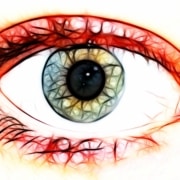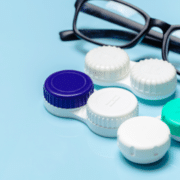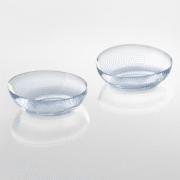Contact Lenses for Vision Correction: The Basics
What Are Contact Lenses?
Contact lenses are thin, transparent discs that are worn in the eye to enhance vision. These lenses rest on the tear film that covers the cornea.
Similar to eyeglasses, contact lenses correct vision problems caused by refractive errors. A refractive error occurs when the eye fails to properly refract, bend, or focus light, resulting in a blurred image.
Contact lenses can improve vision for individuals with the following refractive errors:
- Myopia (nearsightedness)
- Hyperopia (farsightedness)
- Astigmatism (distorted vision)
- Presbyopia (age-related changes in near vision)
Types of Contact Lenses
Contact lenses are made from various types of plastic, with hard and soft lenses being the most common.
Hard contact lenses:
The most prevalent type of hard contact lens is the rigid gas permeable (RGP) lens. These lenses are typically composed of plastic and other materials. They maintain their shape firmly while allowing oxygen to pass through to the eye.
RGP lenses are particularly beneficial for individuals with astigmatism and keratoconus, a condition characterized by an unevenly curved cornea. People who have allergies or tend to develop protein deposits on their lenses may also prefer RGP lenses.
Soft contact lenses:
The majority of individuals opt for soft contact lenses due to their enhanced comfort and a wider range of options. Here are various types of soft lenses:
Daily wear contacts: These lenses are worn while awake and removed before sleep. Many are disposable, meaning that a new pair is used each day. Alternatively, there are options that last longer and only need replacement once a week, every two weeks, or every month. If you only wear contacts occasionally, some ophthalmologists recommend disposable daily-wear lenses.
Extended-wear contacts: These lenses can be worn overnight but should be removed for cleaning at least once a week. However, fewer eye doctors recommend extended wear contacts due to the increased risk of serious eye infections.
Toric contacts: These lenses correct vision for individuals with astigmatism, although not as effectively as hard lenses. Toric lenses can be worn daily or for extended periods, but they often carry a higher cost than other soft contact lenses.
Colored (tinted) contacts: Vision-correcting contact lenses can be tinted to change the color of the eyes. They are available as daily wear, extended wear, and toric lenses.
Decorative (cosmetic) contacts: These lenses are primarily used to alter the appearance of the eyes but do not correct vision. They include colored contacts and lenses that can make the eyes resemble vampires, animals, or other characters. Additionally, they are utilized to conceal certain eye problems present from birth or caused by injuries. Although they do not correct vision, a prescription is required for decorative contacts. These lenses must be regularly and thoroughly cleaned as instructed to prevent dangerous eye infections.
It’s important to note that decorative contact lenses can lead to serious eye problems. Your eyes are incredibly important and delicate. Ensure that your contact lenses are medically safe and FDA-approved.
Contacts should not be treated as fashion accessories or cosmetics. They are medical devices that necessitate a prescription from an eye care professional.
Non-prescription costume contacts can result in cuts, open sores, and potentially blinding infections in the eyes. In addition to experiencing severe pain, surgical intervention such as a corneal transplant may be required, and in some cases, permanent blindness may occur.
If you desire decorative contact lenses, consult an eye care professional.
Different Types of Contact Lenses
Presbyopia Contacts: These contact lenses are specifically designed to address the vision issues that typically arise after age 40, making it difficult to see nearby objects clearly. Various options are available for these corrective lenses, including bifocal or multifocal contacts and monovision correction. In monovision correction, one eye wears a lens for near vision while the other eye wears a lens for distance vision.
Hybrid Contact Lenses: These lenses have a rigid center surrounded by a soft outer ring. They offer the sharp vision provided by rigid lenses while ensuring the comfort of soft lenses.
Scleral Contact Lenses: Gas permeable (GP) lenses that cover the cornea and rest on the white part of the eye, known as the sclera. These lenses are larger in size and are effective in correcting vision problems caused by irregularly shaped corneas, such as corneal scars, keratoconus, or previous surgeries. Some individuals may find them more comfortable than regular GP lenses.
Bandage Lenses: These contacts do not have a prescription but cover the cornea’s surface for added comfort after an eye injury or surgery.
Proper Care for Contact Lenses
It is crucial to clean, disinfect, and store your contact lenses correctly to avoid the risk of serious eye infections. Follow the instructions provided by your eye care provider precisely.
Risks Associated with Contact Lenses
Wearing old or ill-fitting contact lenses can lead to eye scratches and the growth of blood vessels into the cornea, a dangerous condition that poses a threat to your vision.
Using certain eye drops with contact lenses can also cause complications. It is advisable to avoid using any eye drops while wearing contacts, except for wetting drops or preservative-free lubricating drops recommended by your eye doctor.
If you experience symptoms such as intense redness, pain, excessive watering, light sensitivity, blurry vision, or discharge (ooze or pus) from your eyes, it is essential to remove your contact lenses and promptly seek assistance from your eye doctor. These symptoms could indicate serious eye problems.
Taking Proper Care of Your Contacts
Always clean and disinfect any contact lens you remove from your eye before reinserting it. Various types of cleansing systems are available, so consult your eye doctor to determine the appropriate cleaning solutions for your specific lenses, considering factors such as lens type, allergies, and protein deposits.
To prevent dangerous eye infections, it is crucial to clean and store your lenses correctly. Follow these guidelines:
Cleaning and Storage Instructions:
Adhere to the schedule provided by your eye doctor for wearing and replacing your lenses.
Follow the directions given by your doctor, the contact lens manufacturer, and the lens cleaning solution manufacturer regarding cleaning and storing your lenses.
If your lenses have been stored for a long time, consult the instructions to see if re-disinfection is necessary before wearing them. Never wear contact lenses stored for 30 days or longer without re-disinfecting.
Have regular eye exams: To ensure proper fit and prescription accuracy, it is important to visit your eye doctor regularly. Over time, contact lenses can warp, and changes in your cornea can occur.
Avoid water contact: Refrain from wearing contacts while showering, swimming, using a hot tub, or engaging in activities where water may enter your eyes. Contact lenses and water are not compatible.
Don’t sleep with daily wear lenses: Do not sleep while wearing daily wear contact lenses. Remove them before sleeping and follow the recommended usage guidelines.
Clean and rewet carefully:
- Before handling your contact lenses, wash your hands thoroughly with soap and water. Dry them using a lint-free towel.
- Regardless of the type of lens cleaning solution you use, employ a “rub and rinse” cleaning method.
- Gently rub your contact lenses with clean fingers, then rinse them with the solution before soaking.
- Never moisten your contacts with saliva or put them in your mouth. Saliva is not a sterile solution.
- Avoid rinsing or storing your contacts in water, whether it’s tap water or sterile water.
- Homemade saline solutions should never be used.
- Saline solution and rewetting drops are not suitable for disinfecting your lenses. They do not possess disinfectant properties.
- Use a fresh batch of solution each time you clean and disinfect your contact lenses. Refrain from reusing or topping off old solution.
- Do not transfer contact lens solution into a different container, as it will compromise its sterility.
- Ensure that the tip of the solution bottle does not come into contact with any surface. Keep the bottle tightly closed when not in use.
Care for your contact lens case:
Maintain the cleanliness of your contact lens case. Rinse it with sterile contact lens solution (not tap water) and leave it open to air dry.
Replace your contact lens case at least every three months, or immediately if it becomes cracked or damaged.
Are Contacts Suitable for You?
While millions of people choose to wear contact lenses, they may not be suitable for everyone. You may not be able to wear contacts for the following reasons:
- Frequent occurrences of eye infections.
- Severe allergies or persistent dry eyes that are challenging to manage.
- Working or residing in excessively dusty environments.
- Inability to properly care for your contact lenses.
For comfortable and clear vision with contact lenses, it is essential that your cornea and tear film are healthy. Commitment to proper care and timely replacement of lenses is crucial. Consult with your ophthalmologist or eye care professional to discuss your vision needs and expectations. They can guide you in determining whether contact lenses are a suitable option for you.
If you are interested in obtaining contact lenses, schedule an appointment with your primary care physician to begin the process. At Kirman Eye we can provide the best technology, the latest scientific information, and the highest quality treatment available. We are always happy to answer your questions and will work with you to find the ideal solution for you.
Your partners at Kirman Eye are passionately dedicated to providing our patients with the best and most effective eye-care options available when anticipating all of your optical needs.
Contact us to work with you today!














Leave a Reply
Want to join the discussion?Feel free to contribute!